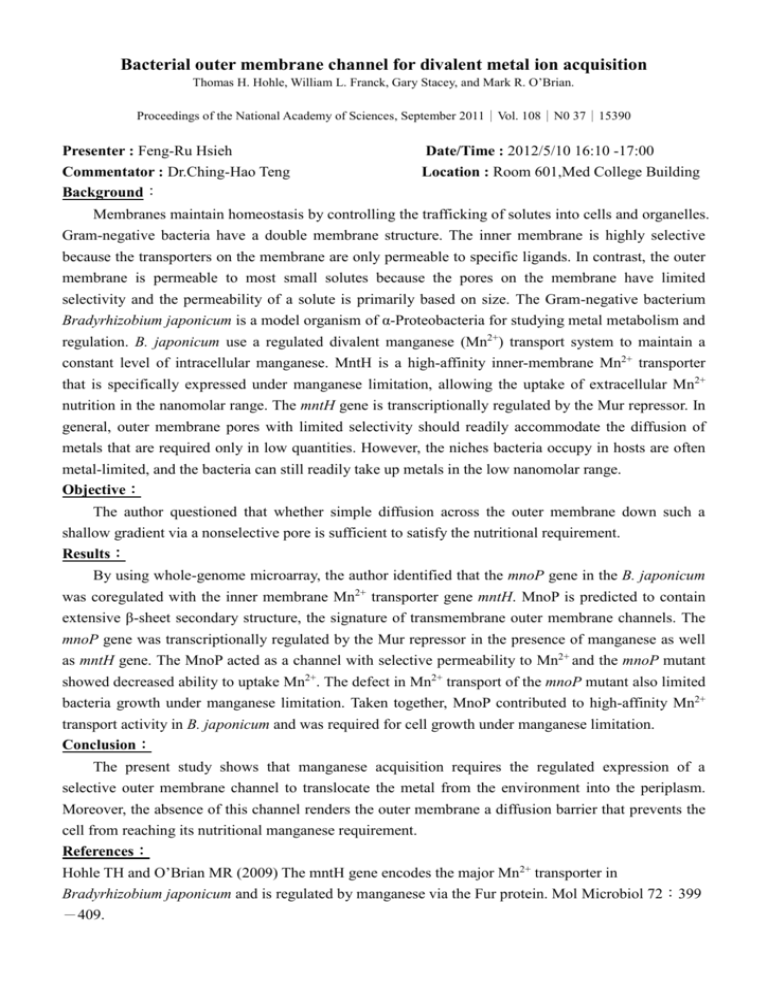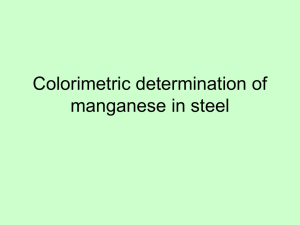Bacterial outer membrane channel for divalent metal ion acquisition
advertisement

Bacterial outer membrane channel for divalent metal ion acquisition Thomas H. Hohle, William L. Franck, Gary Stacey, and Mark R. O’Brian. Proceedings of the National Academy of Sciences, September 2011|Vol. 108|N0 37|15390 Presenter : Feng-Ru Hsieh Commentator : Dr.Ching-Hao Teng Background: Date/Time : 2012/5/10 16:10 -17:00 Location : Room 601,Med College Building Membranes maintain homeostasis by controlling the trafficking of solutes into cells and organelles. Gram-negative bacteria have a double membrane structure. The inner membrane is highly selective because the transporters on the membrane are only permeable to specific ligands. In contrast, the outer membrane is permeable to most small solutes because the pores on the membrane have limited selectivity and the permeability of a solute is primarily based on size. The Gram-negative bacterium Bradyrhizobium japonicum is a model organism of α-Proteobacteria for studying metal metabolism and regulation. B. japonicum use a regulated divalent manganese (Mn2+) transport system to maintain a constant level of intracellular manganese. MntH is a high-affinity inner-membrane Mn2+ transporter that is specifically expressed under manganese limitation, allowing the uptake of extracellular Mn2+ nutrition in the nanomolar range. The mntH gene is transcriptionally regulated by the Mur repressor. In general, outer membrane pores with limited selectivity should readily accommodate the diffusion of metals that are required only in low quantities. However, the niches bacteria occupy in hosts are often metal-limited, and the bacteria can still readily take up metals in the low nanomolar range. Objective: The author questioned that whether simple diffusion across the outer membrane down such a shallow gradient via a nonselective pore is sufficient to satisfy the nutritional requirement. Results: By using whole-genome microarray, the author identified that the mnoP gene in the B. japonicum was coregulated with the inner membrane Mn2+ transporter gene mntH. MnoP is predicted to contain extensive β-sheet secondary structure, the signature of transmembrane outer membrane channels. The mnoP gene was transcriptionally regulated by the Mur repressor in the presence of manganese as well as mntH gene. The MnoP acted as a channel with selective permeability to Mn2+ and the mnoP mutant showed decreased ability to uptake Mn2+. The defect in Mn2+ transport of the mnoP mutant also limited bacteria growth under manganese limitation. Taken together, MnoP contributed to high-affinity Mn2+ transport activity in B. japonicum and was required for cell growth under manganese limitation. Conclusion: The present study shows that manganese acquisition requires the regulated expression of a selective outer membrane channel to translocate the metal from the environment into the periplasm. Moreover, the absence of this channel renders the outer membrane a diffusion barrier that prevents the cell from reaching its nutritional manganese requirement. References: Hohle TH and O’Brian MR (2009) The mntH gene encodes the major Mn2+ transporter in Bradyrhizobium japonicum and is regulated by manganese via the Fur protein. Mol Microbiol 72:399 -409.








